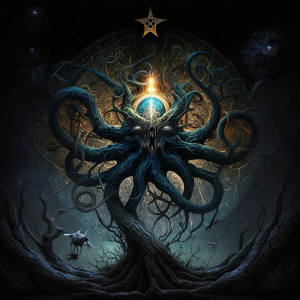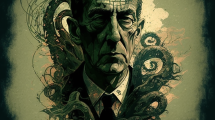To say that Lovecraftian lore is a thing of myth and legend would be an understatement. The strange and terrifying tales crafted by H.P. Lovecraft throughout his lifetime have captivated readers for generations, leaving behind a legacy of supernatural terror unlike any other in the annals of literature. As we traverse this eldritch realm of cosmic horror, let us explore some of its most chilling secrets, from ancient gods to unspeakable horrors beyond mortal understanding.
Throughout his works, Lovecraft often used anachronisms such as “thee” and “thou,” lending them a timeless quality with echoes of antiquity and mystery that still fascinate readers today. His stories weave together elements inspired by weird fiction writers like Edgar Allan Poe, Arthur Machen, Algernon Blackwood, Lord Dunsany and Robert W. Chambers – all while creating something entirely new and unique unto itself. With themes such as insanity, alienation and fear of the unknown permeating many of his works, it’s no wonder why they remain so popular even decades after their original publication dates.
In short: if you’re looking for spine-tingling thrills that will stay with you long after reading them, look no further than Lovecraftian lore! From sea monsters to cursed books to forgotten cults – these are tales guaranteed to leave your heart pounding in anticipation as you venture into the depths of an eerie world full of inexplicable terrors just waiting to be discovered…
Definition
Lovecraftian lore is a genre of horror fiction that draws on the works of H.P Lovecraft, an early 20th century writer who had a profound impact on this type of literature. It’s characterized by its use of cosmic dread–a feeling of overwhelming terror and insignificance in the face of incomprehensible forces beyond our control. These stories often feature monsters or creatures outside traditional notions of reality, which can cause immense psychological trauma to characters within them. Mythos-based elements are also common, with references to ancient gods, cults, and other supernatural beings used as themes throughout these tales. The result is a unique blend of fear, mystery and mythological fantasy that has captivated readers for decades. With its dark themes and eldritch horrors, it’s no wonder why lovecraftian lore remains popular today. Its enduring legacy speaks volumes about how powerful such tales can be when crafted properly. As we move forward into exploring the origins of this genre, one thing remains certain: these stories have stood the test of time for their ability to make us question what lies beyond our realm of understanding.

Origins Of The Genre
The origins of the lovecraftian genre can be traced to a single year – 1926. This was when H.P Lovecraft published his iconic story, ‘The Call of Cthulhu’. In the years since, this tale has become one of the most influential works in horror fiction and is credited with helping to create the modern sub-genre known as ‘Lovecraftian Horror’.
This type of fiction draws heavily on themes that are both supernatural and cosmic in nature. It often features creatures from other dimensions or realms beyond our own reality; sometimes they appear in physical form while others remain shrouded in mystery, creating an atmosphere of dread and fear. Many authors have used these elements to craft tales that explore hidden truths about our world and its inhabitants.
These stories typically feature protagonists who are ordinary people thrust into extraordinary circumstances by forces outside their control. They may find themselves up against ancient gods, alien intelligences, or unspeakable horrors from beyond the stars – all with potentially devastating consequences for humanity’s future. Through it all, readers are left wondering if there is any hope for mankind against such overwhelming odds. By delving deeper into these mysteries, readers gain insight into what lies beneath our everyday lives. With each new discovery comes greater understanding – but also greater danger…Transitioning now to key authors and works that define lovecraftian lore today.
Key Authors And Works
Lovecraftian lore is defined by the works of several authors. Chief among them are H.P Lovecraft, August Derleth and Robert Bloch. Their stories contain a distinctive blend of supernatural horror, cosmicism and terror which has captivated readers for generations.
H.P Lovecraft was an American author who wrote during the early 20th century and pioneered the genre of ‘weird fiction’ with tales such as The Call Of Cthulhu and At The Mountains Of Madness. His writing often involves themes such as forbidden knowledge, alien deities, ancient ruins, lost civilizations and elder gods. He also popularized concepts like ‘the Great Old Ones’, ‘cosmic entities’ and otherworldly realms beyond human understanding – all staples in modern lovecraftian literature.
August Derleth was an editor and publisher who worked closely with Lovecraft during his lifetime. After Lovecraft’s death, he continued to build upon his stories to form what became known as ‘The Mythos’. This expanded universe included many new characters, creatures, locations and plot elements that enriched the original body of work created by Lovecraft himself. Similarly, Robert Bloch was another contemporary writer who used Lovecraft’s ideas in his own writings. Together these three authors laid down the foundations for future writers to explore this unique brand of horror literature further. With their legacy secured in ongoing popularity, their works will continue to enthrall readers for years to come; transitioning now into the next topic: Cosmicism & Terror.

Cosmicism And Terror
The terror of cosmicism has been a pervasive theme throughout centuries, stretching back to the days of Homer’s Odyssey. It is an aesthetic that captures humanity’s helplessness in the face of an indifferent and uncaring universe. This fear can be seen in many works of horror literature by H.P Lovecraft, who wrote extensively on this subject. His stories are filled with eldritch horrors, unfathomable forces and unknowable entities that drive man to madness when confronted with them.
In Lovecraft’s tales there is no respite from the fear as he often uses things like dreams or visions to reveal truths about his world that one could not perceive while awake – giving readers a sense of dread even after they have closed the book. The idea of something beyond our comprehension lurking just behind reality also adds to this feeling of unease; these hidden powers cannot be fully understood but their influence looms large over all mankind.
This type of horror does not necessarily need supernatural elements for it to be effective, instead relying more on psychological terror than physical danger: a sense of being overwhelmed and powerless against some unseen force which may never be discovered let alone defeated. In such situations we may find ourselves clinging desperately onto fragments of hope despite its futility, hoping vainly for resolution in what little remains understandable within our experience.
Mythos Creatures And Entities
The pantheon of creatures and entities within the Cthulhu mythos is vast, varied, and utterly horrifying. From the titular Great Old One himself to the Deep Ones that inhabit sunken cities beneath our seas; from shapeshifting aliens such as the Mi-Go to otherworldly horrors like Nyarlathotep and Yog-Sothoth – each entity has its own unique set of powers, weaknesses, habits, and motivations. All are unified in their goals to bring about an endgame for humanity, which usually involves enslavement or death.
Some mythos creatures may be able to manipulate material objects through magical means while others possess mental abilities such as telepathy or mind control. Many have a physical form but can also exist interdimensionally beyond time or space. It is this versatility that makes them so dangerous and unpredictable to those who cross paths with them.
Though some may view these beings as mere legend or superstition, there is evidence that they do indeed exist regardless of whether one chooses to believe it or not. To ignore their existence would be foolishness at best – even if we choose not to interact with them directly. With knowledge comes power: understanding how they operate will help us prepare ourselves should we ever come face-to-face with any of these creatures. Moving on then…

Key Themes
Lovecraftian lore is filled with many key themes, from cosmic horror to the search for knowledge in a hostile universe. To illustrate this, let us consider the story of Randolph Carter, an American scholar and explorer who discovers a mysterious book known as The Necronomicon. In his travels around New England during the 1920s he uncovers secrets about dark entities such as Cthulhu and Hastur that terrorize both mind and body. He also finds evidence of ancient civilizations that once populated these lands before they were destroyed by some unknown force. This search for knowledge often leads him into dangerous situations but it ultimately reveals new insights into our own world and how we can protect ourselves from its hidden horrors.
The presence of supernatural beings is another recurring theme throughout Lovecraftian lore. These creatures often appear in monstrous forms or possess great powers which threaten humanity’s existence. One example of this is Nyarlathotep, an entity said to be a manifestation of chaos itself. This being has been described as having multiple faces and a thousand arms – all used to spread destruction across the world. Similarly, Yog-Sothoth – one of the Old Ones – is said to be able to traverse time and space at will while wielding immense power over reality itself. Ultimately, these forces challenge mankind’s understanding of the natural order while offering glimpses into otherworldly realms beyond comprehension.
These two examples demonstrate how fear and fascination are interwoven throughout Lovecraftian literature; even though readers may shudder at descriptions of tentacled monstrosities or powerful gods, there remains something strangely captivating about them too. With each discovery comes greater understanding yet also further uncertainty -and that uneasy balance between curiosity and dread lies at the heart of what makes lovecraftian lore so unique and compelling.. Moving on then….the next section looks specifically at ‘The Necronomicon’, exploring its origins and influence within popular culture
The Necronomicon
The Necronomicon is an ancient tome of forbidden knowledge created by the mad Arab Abdul Alhazred in the 8th century. It contains dark secrets, forgotten spells and rituals that could summon ancient evils from beyond time and space. The book has been kept secret for centuries and only fragments remain today, but it is still sought after by those who wish to unlock its hidden mysteries.
Its contents are said to be written in a language older than any known tongue, with passages describing unspeakable horrors that lurk at the edge of our reality. Legends tell of how some have gone mad upon reading its pages or simply disappeared while seeking out its secrets. Despite this danger, many seek out the book’s power as it promises great rewards if one can master it.
It remains unknown what consequences will come from unlocking these long-forgotten secrets, but whatever they may be, few would dare tread into such dangerous territory without caution – even though curiosity often outweighs fear when faced with the allure of such power. With this thought in mind we take leave now, venturing forth towards dreamlands and other dimensions….

Dreamlands And Other Dimensions
The Dreamlands and Other Dimensions are an integral part of Lovecraftian lore. They form a vast, interconnected web that interweaves with the physical world in mysterious ways. In these realms, one can explore secret passages to ancient civilizations or encounter alien creatures from beyond our understanding. Here are some key points about this fascinating subject:
- The Dreamlands are a realm of dreams and visions accessible through lucid dreaming and astral projection.
- It is described as being populated by exotic creatures such as ghouls, nightgaunts, and shantaks.
- Within its boundaries exist strange cities like Celephais and Ulthar, each with their own unique histories and secrets.
- There are many different planes of existence within the Dreamlands including those inhabited by gods, demons, aliens, and otherworldly forces.
- Access to these realms is often gained through ritualistic practices involving trance states or occult incantations.
A major theme running throughout Lovecraft’s stories is the exploration of alternate dimensions – whether they be real or imaginary – which contain hidden knowledge inaccessible to us in our mundane lives. These realms serve as gateways into new realities where we may encounter cosmic horrors beyond human comprehension while also discovering powerful artifacts capable of altering reality itself. As readers delve deeper into these unknown regions they gain insight into the unknowable mysteries lurking just outside our reach. With every journey comes greater understanding yet ever more dread…
Adaptations Of Lovecraft’s Work
Lovecraft’s works have transcended the ages, inspiring countless adaptations in various media. From his stories to his themes and characters, Lovecraft has created a legacy of horror that continues to haunt us today.
| Adaptation | Creator | Platform |
|---|---|---|
| Call of Cthulhu (2005) | Cyanide Studios | PC/ Console Games |
| Re-Animator (1985) | Stuart Gordon & Brian Yuzna | Film |
| The Haunter of the Dark (2015) | Heather Albano & Aaron A. Reed | Interactive Fiction Game |
These adaptations often explore different avenues for their interpretation of Lovecraft’s writing, retelling or expanding upon beloved moments from his original tales such as Call of Cthulhu’s investigation into The Great Old Ones, Re-Animator’s campy homage to Herbert West – Reanimator, and The Haunter of the Dark’s modern take on cosmic horrors. Each adaptation seeks to bring something new while still honouring Lovecraftian lore. Whether through film, games or interactive fiction titles, these interpretations ensure that the terror he wrote about lives on in our hearts and minds long after we put down each story.
In this way, fans can immerse themselves further into a world full of eldritch monsters and forbidden knowledge without ever having to leave their homes. From cult classic films like Re-Animator to newer takes like Call of Cthulhu there is no shortage of ways to experience the dread inspired by Lovecraft himself.

Popular Culture References To Lovecraftian Lore
The influence of Lovecraftian lore on popular culture is undeniable. Its themes and elements have been adapted into a myriad of literary, filmic and video game works for decades; these adaptations often pay homage to the original source material or serve as extensions of it. From horror films such as The Evil Dead (1981) to video games like Bloodborne (2015), Lovecraftian lore has seeped its way into many aspects of modern media.
It’s interesting to note that some stories which draw upon Lovecraftian mythos are themselves part of an expansive universe – such as Clive Barker’s Hellraiser franchise or the Cthulhu Mythos shared world series edited by Robert M. Price. Some authors even use their own spin on various cosmic entities described in Lovecraft’s works, introducing new creatures with different powers and motives. This only serves to further expand upon his legacy and grow the scope of this beloved genre.
As we can see, there are countless ways in which Lovecraftian lore continues to shape our collective consciousness today through literature, film, television and more. With each adaptation comes a renewed interest in his work and newfound appreciation for what he was able to create all those years ago. It is inspiring to witness how far-reaching his impact truly is and will surely continue be for generations yet to come. Moving forward then, let us explore the modern development of this genre…
Modern Development Of The Genre
The modern development of the genre has been nothing short of remarkable. It began in the early 20th century, when H.P Lovecraft wrote his groundbreaking stories about cosmic horror and unknowable entities from beyond our realm of understanding. His influence was felt almost immediately by other authors, who crafted their own tales inspired by this newfound mythos. The Cthulhu Mythos had arrived, and it showed no signs of slowing down.
Soon after, a wealth of new works emerged that built upon these ideas and expanded on them even further. Writers like Robert Bloch and August Derleth established their own branches within the ever-growing landscape of lovecraftian lore. This gave way to more experimental pieces as well; with writers such as David Langford and Neil Gaiman exploring its boundaries to create entirely fresh narratives that pushed the limits of what could be done within this particular subgenre.
Today, lovecraftian lore remains an integral part of popular culture; its themes being explored in countless TV shows, films, video games, books and comics alike. Its impact can still be seen throughout many different mediums – from contemporary movies like ‘Color Out Of Space’ to videogames like Bloodborne – making it clear that Lovecraft’s unique vision is here to stay for years to come.
Frequently Asked Questions
What Are The Most Popular Adaptations Of Lovecraft’s Work?
H2: What are the most popular adaptations of Lovecraft’s work?
When discussing one of the greatest horror authors in literature, H.P. Lovecraft is always at the forefront of conversations. His stories have inspired generations and his influence can still be felt today through various works. Over the years, many filmmakers, directors, writers and artists have adapted his stories into films, television shows and even video games. So what are some of the most popular adaptations of Lovecraft’s work?
The film adaption “Re-Animator” (1985) has become a cult classic amongst fans around the world. Based on an early story by Lovecraft called “Herbert West – Reanimator” it follows Herbert as he attempts to reanimate dead tissue with some grisly consequences. The film gained much praise for its dark sense of humour and over-the-top gore effects that made it stand out from other similar movies at the time. It also spawned two sequels which cemented its importance in modern culture up till this day.
Another well known adaptation was found in gaming circles with “Cthulhu Saves The World”. Released in 2011, this RPG game incorporates many elements from Lovecraftian lore including characters such as Cthulhu himself and references to numerous books written by him throughout the game play experience. Its cartoonish art style combined with unique battle mechanics make it a standout within both indie and mainstream titles alike.
Popular culture continues to pay homage to H.P Lovecraft’s legacy through these adaptations which capture his vivid imagination and twisted tales perfectly for every generation to enjoy anew; proving yet again why he is considered one of the greats when it comes to horror fiction writing!

How Has Lovecraftian Lore Been Interpreted In Popular Culture?
The influence of Lovecraftian lore has been pervasive in popular culture since its inception. From films to comics and television shows, this fascinating body of literature has served as a source of inspiration for many creatives. It’s no surprise then that we’ve seen countless interpretations of this mythos over the years. How have these adaptations taken shape? Let’s take a closer look at how Lovecraftian lore has been interpreted in popular culture.
Many movies have used themes from Lovecraftian stories as jumping off points when creating their own unique narratives. The classic “Re-Animator” (1985) is one example that springs to mind, but more recently we’ve seen such titles as “Color Out Of Space” (2019) which brings an updated spin on some of the older concepts presented by HPL himself. Even video games like Bloodborne (2015) are heavily influenced by his works, providing gamers with a rich atmosphere full of cosmic horror and suspenseful combat elements inspired directly from the writings of HP Lovecraft.
In addition to film and gaming adaptations, comic books also serve as another medium through which creators can explore the range of possibilities offered by this particular brand of fiction. We’ve seen numerous series based on various aspects of Cthulhu mythology including The Dreaming (1996), Call Of Cthulhu: The Official Video Game Comic Series (2005), and Neonomicon (2010). These titles provide readers with different takes on classic characters such as Nyarlathotep while still staying true to the original feel created by Lovecraft himself.
It’s clear that many artists recognize the potential contained within this legendary writer’s work, resulting in an incredible variety of interpretations across multiple media forms. Whether it be through cinema or videogames, fans will likely continue to see new spins on old tales for generations to come – all thanks to HP Lovecraft’s profound impact on popular culture today.
What Are The Key Themes In Lovecraftian Lore?
Let’s dive into the mysterious world of lovecraftian lore and explore its key themes. To set the tone, you could say that it is like opening Pandora’s box – once opened, there will be no going back! From cosmic horror to forbidden knowledge, this dark realm has captivated readers for many years. Here are some of the crucial components found within:
- Awe-inspiring entities beyond human comprehension
- Unknowable mysteries about our universe
- Ancient civilizations with sinister secrets
- The dread of mankind’s insignificance in a vast cosmos.
These themes have been resonating through literature since H.P Lovecraft first introduced them in his stories. He created an entire mythology around these concepts which today still inspire storytellers from all mediums. Fans of science fiction can find elements of lovecraftian lore throughout their favorite books, movies, and video games as well. It seems that every year more content is released featuring creatures such as Cthulhu or references to ancient Elder gods coming out from beyond space itself.
Lovecraftian lore encapsulates man’s fear of being powerless against forces greater than himself and entices us with tantalizing glimpses at what lies outside reality without ever providing any answers. This ability to keep audiences guessing and pushing boundaries makes it something unlike anything else in popular culture; a lingering enigma capable of tapping into both primal fears and deep curiosity simultaneously. As we venture further down the rabbit hole, it’s clear why so many people continue to come back again and again for another glimpse into this unique world.

Is The Necronomicon A Real Book?
The Necronomicon has long been a source of fascination for scholars, occultists and horror fans alike. Legends have grown up around this mysterious tome; some say it is an ancient grimoire written by the mad Arab Abdul Alhazred, others believe it is nothing more than fiction created by the great writer H. P. Lovecraft himself. But what is the truth? Is the Necronomicon real or just an invention of a master storyteller?
To answer this question, we must first look at the history behind the book itself. The idea of a dread tome filled with forbidden knowledge can be traced back centuries before Lovecraft wrote his stories about Cthulhu and other monstrous entities. Ancient texts such as The Book Of Enoch, The Sibylline Oracles and even parts of The Bible contain references to supernatural beings that could well be inspirations for Lovecraft’s own creations. It seems likely then that he was familiar with these works when writing his stories in which case he may have incorporated elements from them into his narrative.
However there are still many who claim that the Necronomicon is indeed a real book written by Alhazred in medieval times and hidden away until it was rediscovered in recent years. There may be some evidence to suggest this but ultimately it remains impossible to prove either way due to its alleged age and obscurity. All we can do is speculate on whether or not it exists and if so, where it might be found – though doing so requires tremendous courage given the power attributed to such a dark text!
In any case, whatever one believes about its authenticity there is no denying that the legend surrounding this infamous volume will continue to captivate readers for generations yet come.
What Are The Similarities Between Cosmicism And Terror?
Cosmicism and Terror are two terms that are often used in literary circles to describe the writing of horror fiction. But what exactly do they mean? Are there similarities between these two concepts, or is one more powerful than the other? In this article we’ll explore the concept of cosmicism as it applies to Lovecraftian lore and compare it with terror as a literary device.
At its core, cosmicism is an idea developed by author H.P. Lovecraft which suggests that humanity is insignificant within a vast universe filled with unknowable powers and creatures. This sense of insignificance leads to feelings of dread, horror, and despair for characters within the stories he wrote; thus creating a strong atmosphere of fear in his works. Cosmicism also embodies an element of supernatural horror where events occur outside our understanding of natural laws. It’s this combination that makes cosmicism so effective when applied to literature – both for readers who can identify with the terror being felt by characters, and for those seeking something deeper beyond just feeling scared.
On the other hand, terror tends to rely heavily on suspenseful build-ups and jump scares to create tension in a story. While this may work well in some genres such as slasher films, it lacks the philosophical implications found within cosmicism which adds another layer of depth to any narrative featuring it. That isn’t to say terror doesn’t have its place in lovecraftian lore though – after all, there needs to be enough fear present in order for us as readers/viewers to feel like we’re experiencing true horror rather than merely witnessing it from afar.
In short, cosmicism provides a much more nuanced approach towards creating an atmosphere of terror compared to pure shock value techniques found in certain types of horror entertainment media today; offering up existential questions about our own existence alongside terrifying unknowns lurking beyond what we understand about reality itself. Both elements however play their part in making us question and ultimately experience terror at its finest – no matter how we choose consume them.
Conclusion
At the end of the day, it is clear that Lovecraftian lore is a powerful force in popular culture. It has been interpreted many different ways and its key themes have resonated with audiences for decades. While some may debate whether or not the Necronomicon is real, there are certain similarities between Cosmicism and Terror which can still be felt today. To truly understand this lore, one must think beyond what we see on the surface and delve deep into these dark depths of knowledge to fully grasp its power.
As an expert in lovecraftian lore, I know firsthand how captivating this genre can be. The allusive nature of stories like Call of Cthulhu provide us with a sense of mystery and wonder as we explore worlds beyond our own comprehension. As readers, we become part of an ever-expanding universe filled with creatures from other realms and unknown dimensions that challenge our traditional understanding of reality.
Lovecraft’s work continues to stay relevant due to the sheer scope of his storytelling abilities and creativity. His ability to evoke emotions such as fear, dread, awe – even terror – through words remains unparalleled by any other author in recent history. So while much has changed over time in terms of adaptation and interpretation, one thing remains constant: Lovecraftian lore will continue to enthrall readers for generations to come.





